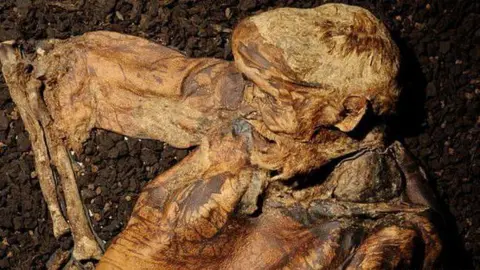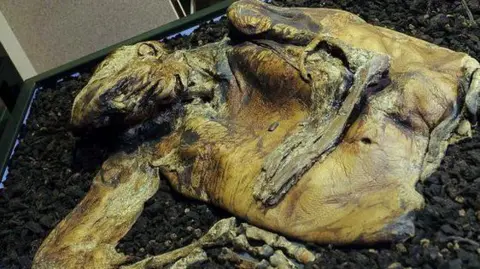Jonny Humphries & Katie Barnfield
BBC News, Manchester

Manchester Museum
The Lindow Man was one of the most significant archaeological finds in the history of the region
The ancient peat bog of Lindow Moss in Cheshire hid a dark and gruesome secret for almost 2,000 years.
But on 1 August 1984, a peat cutter spotted the astonishingly well-preserved remains of an Iron Age man trundling along a conveyer-belt.
The unfortunate victim of a brutal murder, who became known as the Lindow Man, proved to be one of the most significant archaeological finds in the region's history.
But the unique conditions of the bog, near Wilmslow, that preserved him have been under threat, with serious environmental implications.
The unique conditions in a peat bog, which are acidic and exist in an anaerobic state (devoid of oxygen), mean that bodies like Lindow Man can be preserved in good condition for centuries.
Georgie Johnson, organiser for community group Transition Wilmslow, said the discovery of Lindow Man cemented the importance of the bog as a cultural and natural site.
She said: "He'd been fairly perfectly preserved, so we could see what his last meal was, we know how he died, and where he was placed in the bog as well."
In their natural state, peatlands act as carbon sinks and provide a home for plants and animals.

Emeritus Professor John Handley said it would be a "big win for nature" to restore Lindow Moss
But commercial peat-extraction, which continued at Lindow Moss for centuries until it ended in 2016, has caused severe damage.
Emeritus Professor John Handley, from the University of Manchester, told the BBC: "At the moment looking at the ground, you see it's bare, it's got bare peat, it's drying, oxidising.
"It's fossilised carbon, and it's being released into the atmosphere."
Violent attack'
"We want to completely reverse that process," Mr Handley Transition Lindow and the Lindow Moss Partnership, added.
Since 2022, after campaigns from locals and experts, measures have been put in place to re-wet the bog by raising water levels with artificial structures.
Jack Crowshaw, project manager for the Lindow Moss Partnership, described peat bogs like Lindow Moss as "weird" but "wonderful" places that support biodiversity.
He said: "We've got a population of water-vole, that have been here for a long time, a population that is increasing at the moment, and that is partly as a result of interventions like this that hold water at a steady-level throughout the year."

The Lindow Man was one of the most significant archaeological finds in the history of the region
The ancient peat bog of Lindow Moss in Cheshire hid a dark and gruesome secret for almost 2,000 years.
But on 1 August 1984, a peat cutter spotted the astonishingly well-preserved remains of an Iron Age man trundling along a conveyer-belt.
The unfortunate victim of a brutal murder, who became known as the Lindow Man, proved to be one of the most significant archaeological finds in the region's history.
But the unique conditions of the bog, near Wilmslow, that preserved him have been under threat, with serious environmental implications.
The unique conditions in a peat bog, which are acidic and exist in an anaerobic state (devoid of oxygen), mean that bodies like Lindow Man can be preserved in good condition for centuries.
Georgie Johnson, organiser for community group Transition Wilmslow, said the discovery of Lindow Man cemented the importance of the bog as a cultural and natural site.
She said: "He'd been fairly perfectly preserved, so we could see what his last meal was, we know how he died, and where he was placed in the bog as well."
In their natural state, peatlands act as carbon sinks and provide a home for plants and animals.

Emeritus Professor John Handley said it would be a "big win for nature" to restore Lindow Moss
But commercial peat-extraction, which continued at Lindow Moss for centuries until it ended in 2016, has caused severe damage.
Emeritus Professor John Handley, from the University of Manchester, told the BBC: "At the moment looking at the ground, you see it's bare, it's got bare peat, it's drying, oxidising.
"It's fossilised carbon, and it's being released into the atmosphere."
Violent attack'
"We want to completely reverse that process," Mr Handley Transition Lindow and the Lindow Moss Partnership, added.
Since 2022, after campaigns from locals and experts, measures have been put in place to re-wet the bog by raising water levels with artificial structures.
Jack Crowshaw, project manager for the Lindow Moss Partnership, described peat bogs like Lindow Moss as "weird" but "wonderful" places that support biodiversity.
He said: "We've got a population of water-vole, that have been here for a long time, a population that is increasing at the moment, and that is partly as a result of interventions like this that hold water at a steady-level throughout the year."

Manchester Museum
Lindow Man is now one of the most visited attractions in the British Museum in London
Examinations of Lindow Man showed he was in his 20s, of average height, well-built and in good health.
Closer inspections showed he suffered from intestinal parasites and his last meal was unleavened bread.
Radiocarbon dating has put his death, which involved a violent attack including a blow with a weapon such as an axe, as being sometime in the 1st Century AD.
Under the supervision of then county archaeologist Rick Turner, Lindow Man was transported to the British Museum in London where he has been an extremely popular exhibit.
There are several theories about how he met his fate.
Some experts have suggested he could have been sacrificed as an offering to Iron Age gods, whereas others say the evidence only points to the fact he was murdered.
The bog's history is the subject of an ongoing exhibition and art-trail, Window on Lindow, which continues until October.
Lindow Man is now one of the most visited attractions in the British Museum in London
Examinations of Lindow Man showed he was in his 20s, of average height, well-built and in good health.
Closer inspections showed he suffered from intestinal parasites and his last meal was unleavened bread.
Radiocarbon dating has put his death, which involved a violent attack including a blow with a weapon such as an axe, as being sometime in the 1st Century AD.
Under the supervision of then county archaeologist Rick Turner, Lindow Man was transported to the British Museum in London where he has been an extremely popular exhibit.
There are several theories about how he met his fate.
Some experts have suggested he could have been sacrificed as an offering to Iron Age gods, whereas others say the evidence only points to the fact he was murdered.
The bog's history is the subject of an ongoing exhibition and art-trail, Window on Lindow, which continues until October.
No comments:
Post a Comment